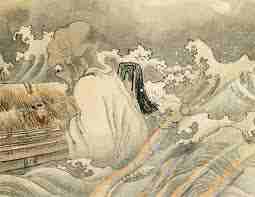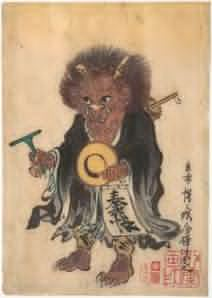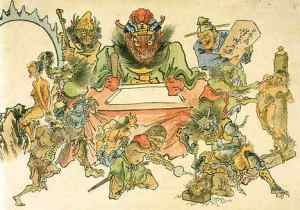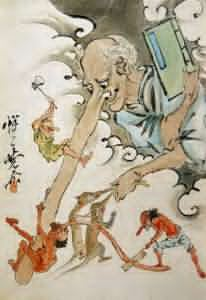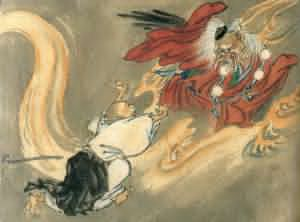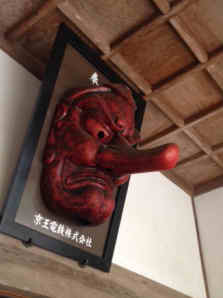Folklore and Art by Kyosai: Tengu and Changing Nature within Buddhism and Shintoism
Lee Jay Walker
Modern Tokyo Times
The Japanese artist Kawanabe Kyosai is fascinating because of his individualistic spirit and this is witnessed in his art. Kyosai, just like the mysterious Tengu, belonged to two worlds and this applies to the old Edo period and the modernization of Japan that began in 1868. The Meiji Restoration of 1868 was truly dynamic and revolutionary – and, likewise, this period also altered the Japanese art scene based on technological advancements and outside influence.
Tengu also belongs to two very different traditions that highlight the power of Shintoism and the mysterious nature of this religion. Not only this, the Shinto impact on Buddhist thought patterns would alter the view of Tengu within Buddhism over the centuries . Therefore, the Tengu becomes part of the richness of nature within the Shinto faith, rather than the dark demons of Buddhism and other faiths that highlight the power of evil. This fact also shows the power of Japanese culture because the indigenous faith of Shinto could absorb different thought patterns and traditions.
Kyosai was born in 1831 and died in 1889, therefore, the rapid changes in society clearly impacted on him. He was an individual who was independent in mind and thought. This reality shines right through the art of Kyosai.
Kusumi Kawanabe, Director of the Kawanabe Kyosai Memorial Museum, comments, “This great artist has grown in stature as we have been able the better to get the Meiji period into perspective. He studied at an early age under Kuniyoshi and later under Kano masters, but eventually he went his own independent way. Essentially a nationalistic painter, he was nonetheless fully aware of Western art – indeed, he dealt with it quite broadmindedly in his book “Kyosai Gadan” published in 1887 – but he was robust enough not to succumb, as so many of his contemporaries did, to the blandishments of foreign styles, and was one of the last great painters in the truly Japanese tradition.”
The main focus of this article is to highlight aspects of Kyosai and to link this with the Tengu and the underworld of Japan. After all, the mysterious creatures, spirits, and ghosts play a powerful role within the culture of this fascinating country. Part of this mystery is visible within various types of yokai (ghosts, monsters, and special apparitions) based on these creatures and spirits – many imbued with supernatural powers – being extremely fascinating.
Within early Buddhist thought patterns, the Tengu were demons and harbingers of bad times. This applies to war and other calamities that would impact negatively on local regions throughout Japan. However, within Shintoism, the Tengu were sometimes worshiped as revered spirits (Shinto kami) that were blessed with magical powers. Therefore, the attributes of the Tengu witnessed major changes within Buddhism based on Shintoism because in time this creature became a more protective force. For example, if we apply this to children, then in early Japanese history the Tengu were believed to abduct children. However, in later history, this all changed because the Tengu became enlisted in searching for children who were scared and needed help quickly.
In other words, the Tengu went from being demonic to being a positive and mysterious force. Yet, despite this transformation, the Tengu still had dark and dangerous powers during special times. Given this reality, local people in the mountains and forests had to tread carefully because the Tengu didn’t take fools lightly.
Another positive side of the Tengu is that their shape-shifting power applies to animal and human forms. This means that their attributes are powerful within Japanese folklore. Not surprisingly, Kyosai highlights the rich nature of Tengu and various different yokai in his intriguing and diverse art.
http://kyosai-museum.jp/ENG/about.htm
http://www.onmarkproductions.com/html/tengu.shtml
Modern Tokyo News is part of the Modern Tokyo Times group
DONATIONS to SUPPORT MODERN TOKYO TIMES – please pay PayPal and DONATE to sawakoart@gmail.com
http://moderntokyotimes.com Modern Tokyo Times – International News and Japan News
http://sawandjay.com Modern Tokyo Times – Fashion
https://moderntokyonews.com Modern Tokyo News – Tokyo News and International News
http://global-security-news.com Global Security News – Geopolitics and Terrorism
PLEASE JOIN ON TWITTER
https://twitter.com/MTT_News Modern Tokyo Times
PLEASE JOIN ON FACEBOOK
https://www.facebook.com/moderntokyotimes
Some art and cultural articles by Modern Tokyo Times are republished in order to highlight the unique reality of Japan to our growing international readership.
